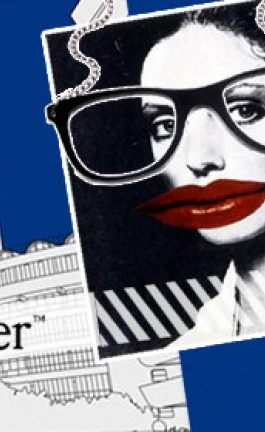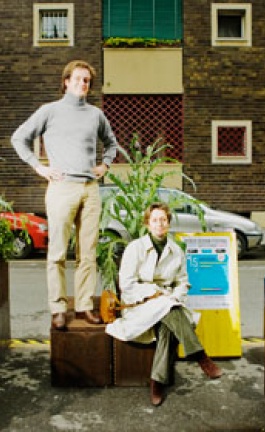Flamtastic Flamtasia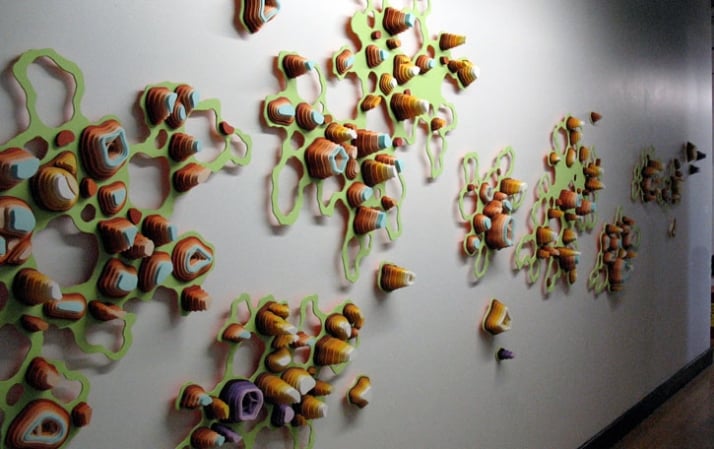
Image Courtesy of Charles Clary
Paper has been the most utilized substrate for creative expression over several centuries. As our relationship with digital interfaces continues to grow, there has been quite a comeback of utilizing paper as a medium of creative exploration and communication. Paper typography, illustrations and sculptures seem to be showing all over. Designers like Yulia Brodskaya, Jen Stark and Richard Sweeney have demonstrated the potential of this wonderful material. We continue to be delighted by all these artists who experiment with, at times, the most overlooked material.
Turn over a new leaf, there is a young artist that uses paper to narrate fiction and displaces viewers into a new fabricated reality. Charles Clary, a Tennessee based artist, layers paper while creating environments, landscapes and organic life forms. His work is viral and literally transformative. Whether is protruding or recessive, Charles Clary seeks to capture not only the viewers but also the spatial qualities where his work sits. Charles sat down with Yatzer to talk and have some fun for paper's sake!
Fermatic Wilderness (Detail)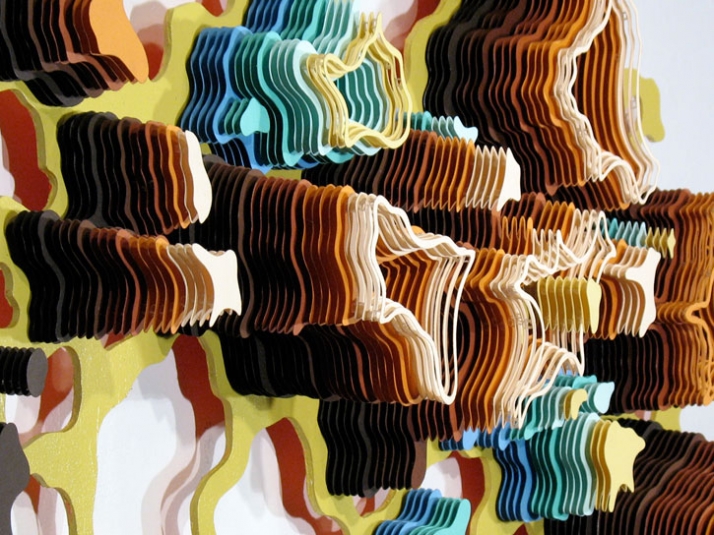
Image Courtesy of Charles Clary
Charles, tells us a bit about your background so those who do not know you get a context of you and the work...
I received my BFA in painting from Middle Tennessee State University, with a minor in Illustration and I also received an MFA in painting from the Savannah College of Art and Design. I am from Tennessee where I still live and work.
I see your work as a blend of science, math, art, biology, architecture and landscapes. As many might see their own combination, how would you describe your work?
I use paper to create a world of fiction that challenges the viewer to suspend disbelief and venture into my fabricated reality. By layering the paper I am able to build intriguing land formations that support both mechanical and organic life forms. These strange landmasses contaminate the surfaces they inhabit with their viral growth, transforming the space into a suitable living environment. Towers of paper and color jut into the viewer’s space inviting playful interactions between themselves and this conceived world. These worlds escape reality, growing beyond my control. With each new evolution, these worlds continue to grow and morph into strange new embodiments, developing new and limitless manifestations of viral like expanses.
Double DIddle Evisceration (Detai)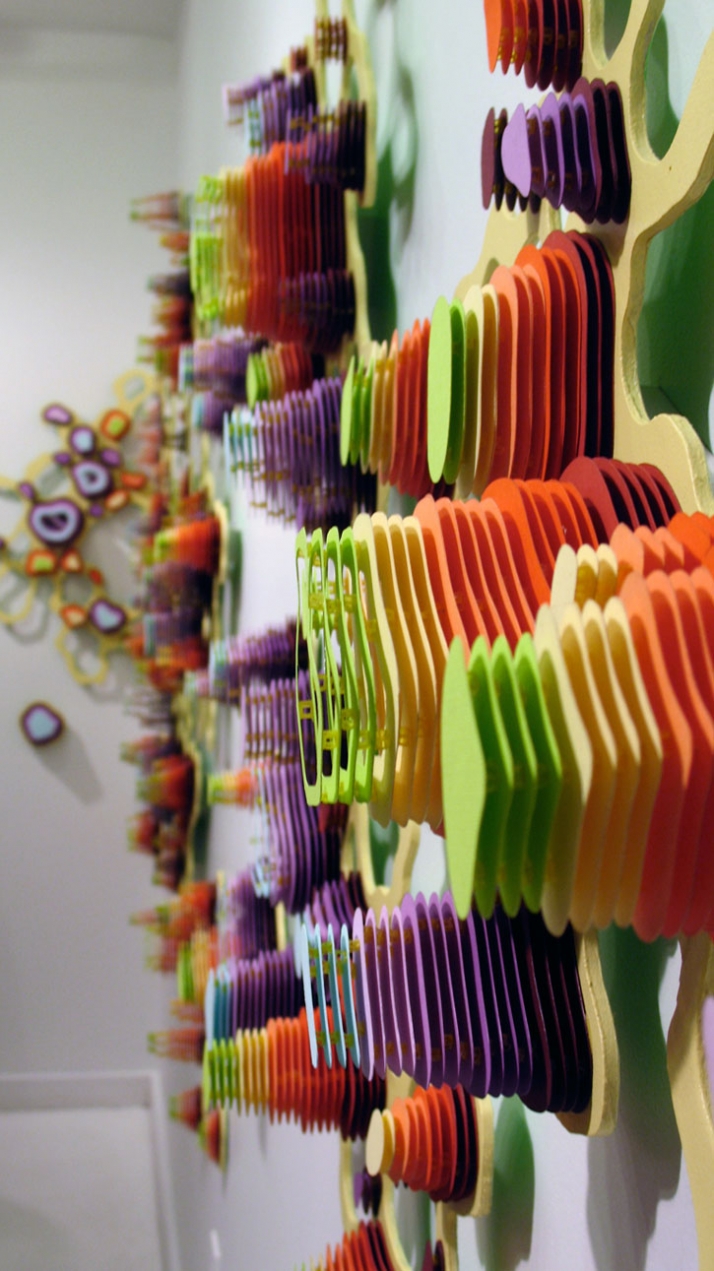
Image Courtesy of Charles Clary
As an artist you probably used paper as a medium to quickly sketch, explore ideas and as part of the process. Now, you utilize paper as the protagonist of your stories as they act as the brush, paint and dimensional canvas, how did you come about using paper as my primary material?
I got to paper as a medium in a very round about way. It started when I was in graduate school and wanted to combine my sketches with my paintings and keep the aspects of both mediums. I started cutting out my drawings and mounting them to my paintings. So now the paintings functioned more as backdrops or environments for these drawings to reside in. Once I got to this point I realized that my paintings were more of a documentation of this viral environment that needed to be physically created. At this point I was awarded a studio space in New York for three months through SCAD and started messing around with cut matt board and happened to find the Bazzil Scrapbooking paper I use today. The paper is a heavy cardstock that has several different texture patterns and comes in a range of 500 individual colors. From there things started happening very fast and my work grew from .25” to 10” of the wall an my matt board supports turned into the stronger wooden supports I use today.
Fermatic Pandemic Movement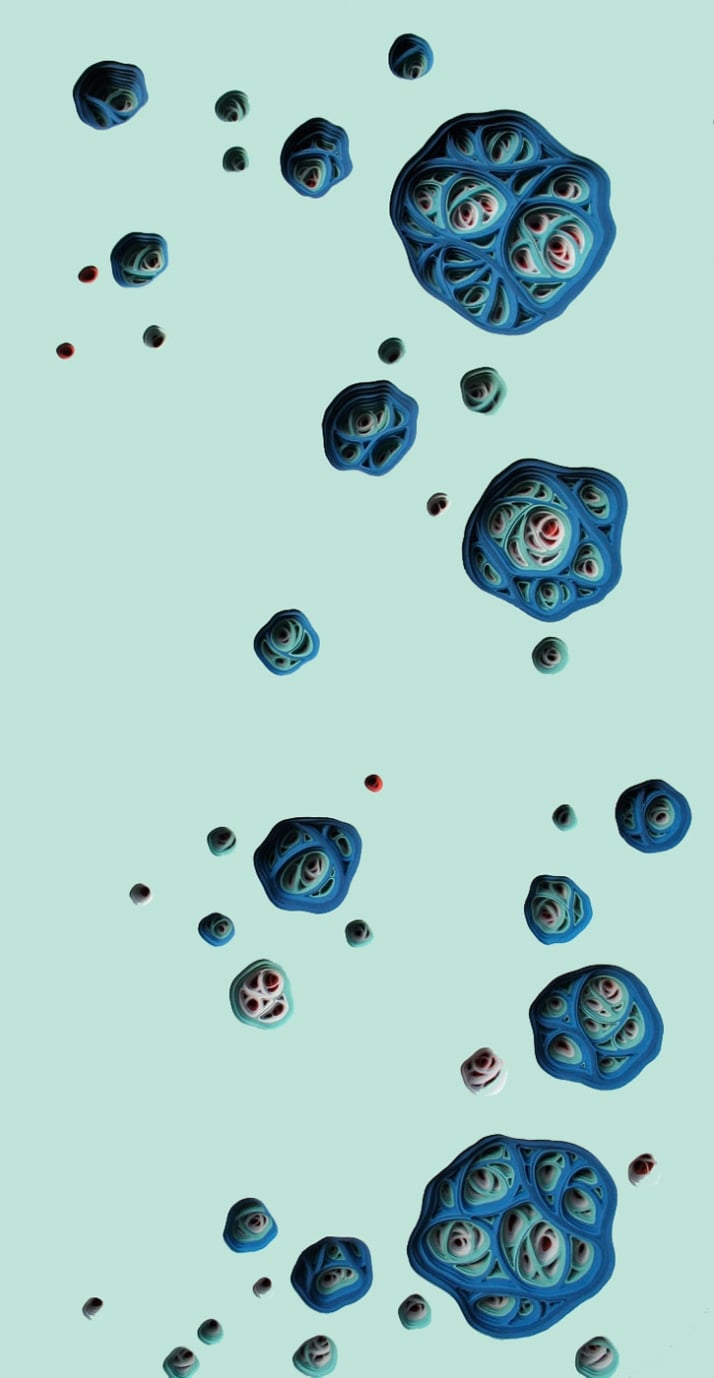
Image Courtesy of Charles Clary
Hugg-a-Diddle Burs (Detail)
Image Courtesy of Charles Clary
It seems that patience, careful preparation and layering are integral facets of your creative process, can you explain to us the process behind your work?
The process is very labor intensive and requires a massive amount of time. I begin the whole process with a wooden support cut from organic shapes that I get from an action based painting process that is only significant to me as a musically based process. I dip hand made drum sticks into acrylic based paint and play passages of music onto a plastic tarp; once these splatterings dry, I peel them up much like you would a fruit roll up from its wax paper base, and use them as stencil patterns for my organic wooden bases. Once I have a wooden form I like, I lay tracing paper down and intuitively find my topographical formations. They are informed from electron microscope images, areal photography, and insect colonies such as: termites, worms, and ants. Once I have my design, I graphite transfer a shape to my darkest or lightest color paper (depending on whether or not it will be a protruding or receding piece) and start cutting. I usually cut one shape out and then trace it out X amount of times to complete that layer then take the negative space that is left and free hand the next layers shape about a .16” of an inch smaller than the last and repeat. Once the 5-6 layers are cut, roughly 30 separate shapes, they form what I call a “tower”, and dependant on how large this “tower” is I will then cut back into the shape to create my crevasse like designs. This part is completely intuitive allowing myself the freedom to cut the design the way in which it wants to be cut. Then I assemble the each individual tower using polystyrene spacers I hand cut to size, roughly 4,000-20,000 can be used in a single work, and then mount them to the wooden panel using archival, clear drying glue. I then assemble the panels together cohesively on the wall allowing the piece to infect the environment in which it is placed.
Hugg-a-Diddle Burs (Detail)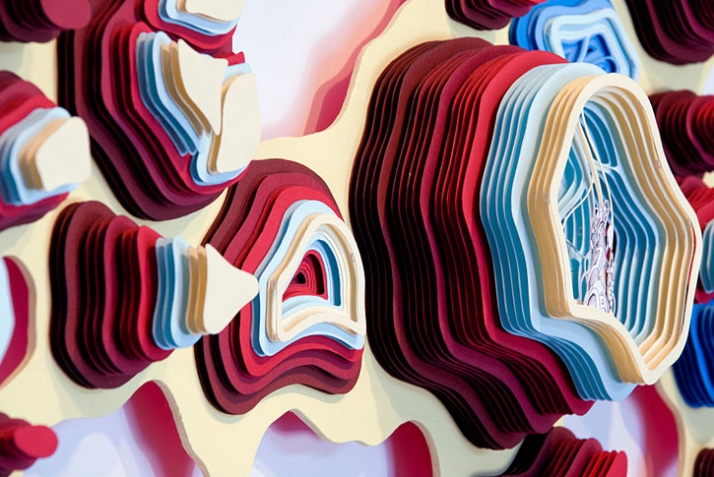
Image Courtesy of Charles Clary
Codastic infestation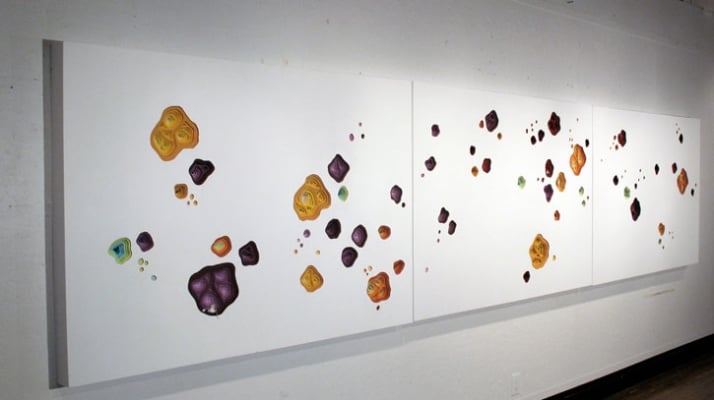
Image Courtesy of Charles Clary
Dimensionality is evident in all your pieces. Whether it is protruding from the wall or recessing from a colored flat surface, depth seems elemental to the work, talk to us about that dimension of your work...
On the wall my work acts as a finite amount space it encompasses. Through scale and color gradients I trick the viewer into believing the space is much larger than it appears to be. My goal is to immerse the viewer in these environments so that they start to loose themselves in it and are completely engaged peripherally. I want you to feel as if these environments could be macro or micro and you don’t really know which without a point of reference. You begin to question whether or not you’re a voyeur into this world or if this world is voyeuristically encroaching upon your own.
As we got to know a whole lot about your work, let's have some fun and see how you stay sensorially engaged... we now know that your pieces take a long time to plan, design and build, so what kind of music do you listen to when creating some of these pieces?
I’m actually all over the place when it comes to listening to music in relation to my work. To name just a minute few I’m a huge fan of the Big Bad Voodoo Daddies, Amon Tobin, Muse, Cat Stevens, Muddy Waters, Anamanaguchi, Protomen, Deltron 3030, Flaming Lips, Star Death and the White Dwarfs, Flobots, I have a guilty pleasure toward Soundtracks but only original scores, so The Time Machine, Batman Forever and Dark Knight, Pans Labyrinth, and anything with a good orchestra.
Image Courtesy of Charles Clary
Codastic Diddlation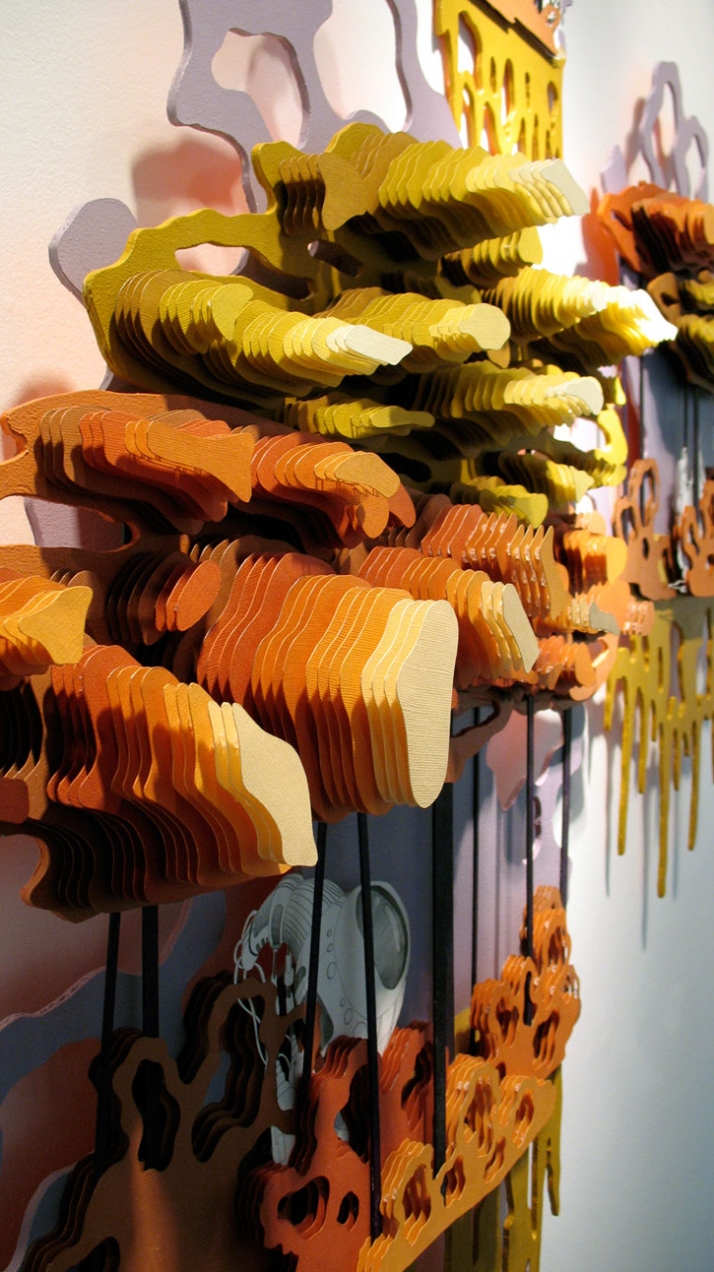
Image Courtesy of Charles Clary
Wow! That is a broad spectrum of music. I must admit that I also share that guilty pleasure of great film scores. That was fun. One last question around the same context... I can only imagine that your work is inspired by multiple sources and disciplines, if your work was composed of frequent dinner guests at your table, who would you invite over?
This is a tough one! I think the guest list would have to include paper artists such as: Jen Stark, Kara Walker, Jane South, and Noriko Ambe. From architecture then you have to have Frank Loyd Wright and anyone working on projects in Dubai, those buildings seem more sculptural than anything I have seen. As far as installation artists I couldn’t leave out people like: Sarah Sze, Matthew Ritchie, Takashi Murakami (even though he isn’t always installation based), Kiel Johnson an amazing artist from the Midwest, and Barry McGee. I’d also have to throw in, Herb Williams, Inka Essenhigh, Mars-1, Jeff Soto, one of the best professors I’ve ever had Craig Drennen, and Yoon Lee and any of the ridiculously talented artists at Pierogi Gallery in Brooklyn NY, just to name a few.
Charles Clary is currently represented by the Rymer Gallery in Nashville, Tennessee. He is currently showing at a group show called "Eye Candy". He has a solo show going up in Dickson, Tennessee at the Renaissance Center in March and then a solo show at The Rymer Gallery in August.
Terr-a-Diddle Formation (left) and drawing by Clary (right)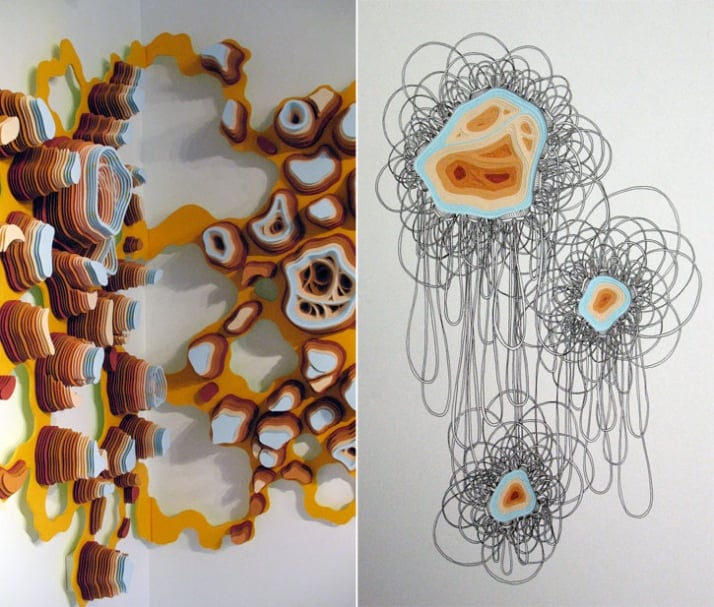
Image Courtesy of Charles Clary
Drawing by Clary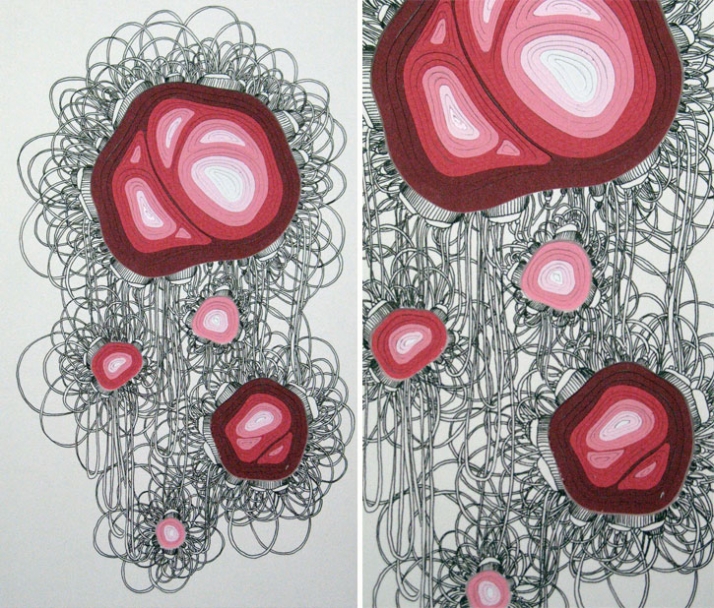
Image Courtesy of Charles Clary
Codastic Expulsion Movement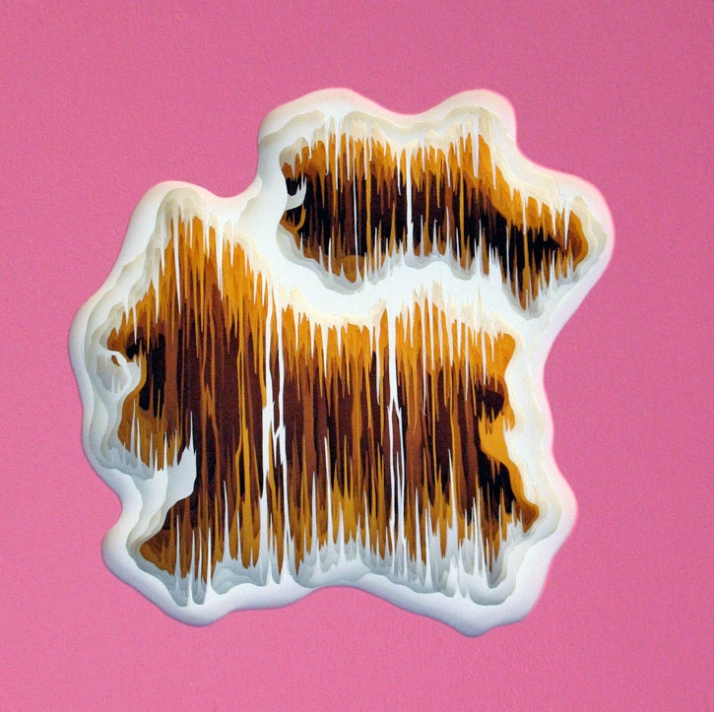
Image Courtesy of Charles Clary
Recent Articles

Jaime Hayon Goes Bestial at His Miami Art Show






